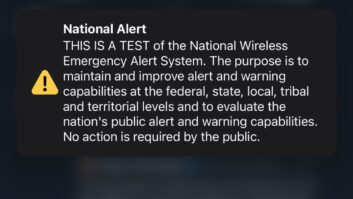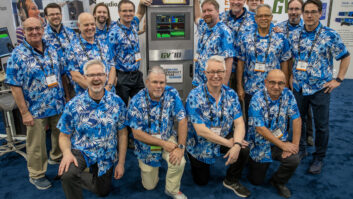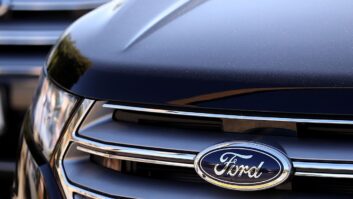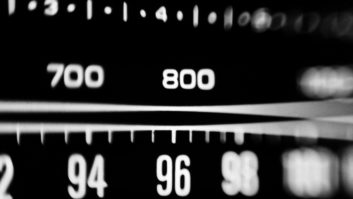The author is executive chairman of the Telos Alliance.
Many years ago, there was a green “pup” of a broadcast engineer who had just been hired by the top FM and AM radio stations in Cleveland, Ohio. A dream job, at that time, and it didn’t take long for this youngster to find out the ropes of the broadcast engineering profession.

Aside from knowing the basics of studio/transmitter maintenance, and equipment troubleshooting, this young lad had a lot to learn. Fortunately, he had a great mentor in the late Jim Somich, who took this fellow left-handed kid under his wing, in hopes he’d eventually amount to something. Aside from Jim giving him the nickname “FoeTie,” seems the kid did alright!
Along the journey of trying to understand what it takes to master the art of broadcast engineering, the phrase “Good Engineering Practice” kept appearing in various procedures, manuals, company technical policies and articles. I wasn’t quite sure what this meant, and many assumptions were drawn about it.
What did Good Engineering Practice entail?
Aside from having a great resource and guidance, from my trusted colleague, I was able to acquire the knowledge through reading and by way of in-the-field experience. This enabled me to ascertain what Good Engineering Practice was all about, and more importantly, a discipline by which to live by it.
PAY IT FORWARD
Today, it seems, the term Good Engineering Practice has been lost within the community, or at least is significantly misunderstood. Our industry has not done enough for those entering, or migrating upward in, the broadcast engineering field. That is the purpose of this article — it is my intention to hopefully “pay it forward” for those in our business, just as Jim did for me.
It would be helpful to delve into the often-used concept of “Good Engineering Practice” that we encounter among engineering circles in the texts of documents such as regulations, technical specifications and standards.
Let’s try to make sense of this phrase that, at first sight, appears a bit obscure. “Engineering,” according to the Accreditation Board for Engineering and Technology (www.abet.org), is described in the following terms:
“Engineering is the profession in which a knowledge of mathematics and natural sciences gained by study, experience, and practice is applied with judgment to develop ways to utilize, economically, the materials and forces of nature for the benefit of mankind.”
Taking that definition as the starting point, we can arrive at basic requisite principles for engineering applications:
1. It is necessary to have work performed by employing theoretical and applied methods to assimilate information on mathematical and natural sciences.
2. It is necessary to employ rational thought upon the information gathered.
3. The objective is to develop best practices by using this information for the establishment of methods that substantiate information in a repeatable manner.
4. It is crucial that findings obtained by the use of such methods convey benefit to the industry.
Having described the required attributes for implementation, loyalty to the application process and identification of moral values, we may commence on the ultimate description of Good Engineering Practice.
The IEEE, before granting membership to candidate engineers, requires the undertaking of certain ethical rules to be observed in the execution of their profession. Those rules are:
1. To accept responsibility in making engineering decisions consistent with the safety, health and welfare of the public and to disclose — promptly — factors that might endanger the public or the environment;
2. To avoid real or perceived conflicts of interest whenever possible, and to disclose them to affected parties when they do exist;
3. To be honest and realistic in stating claims or estimates based on available data;
4. To improve the understanding of technology, its appropriate application and potential consequences;
5. To maintain and improve our technical competence and to undertake technological tasks for others only if qualified by training or experience or after full disclosure of pertinent limitations;
6. To seek, accept and offer honest criticism of technical work, to acknowledge and correct errors and to credit properly the contributions of others;
7. To treat fairly all persons regardless of such factors as race, religion, gender, disability, age or national origin;
8. To avoid injuring others, their property, reputation or employment by false or malicious action;
9. To assist colleagues and co-workers in their professional development and to support them in following this code of ethics.
Approved by the IEEE Board of Directors, August 1990; see https://www.ieee.org/index.
The idea that constitutes the foundation of good engineering is good science. In fact, there is no conflict of concepts between good science and good engineering. What is scientifically good is also good for engineering. No example can be cited in the history of science where a scientifically sound idea has failed in engineering practice.
Good science reveals itself in the disclosure of the secrets of nature, and in turn, those revelations are used in resolving engineering problems. Science and engineering may be developed through empiricism. New discoveries generally originate from empiricism and experimentation.
Good broadcast engineering practices, just like doctrinal precedents in law, are capable of setting foundations and standards through organizations, such as the Society of Broadcast Engineers, National Association of Broadcasters, Audio Engineering Society, International Telecommunication Union and the Institute of Electrical and Electronics Engineers, to name a few.
Now that we have touched upon theory and basics of the subject, let’s turn to implementation. Good engineering is initiated by a good description of anticipated problems or requirements. This is half of the work. Identification, analysis and solution of the problems, which are expressed in the best possible, verifiable, substantiated and repeatable action, in writing, is the realization of good engineering practice.
In everyday life, how does one apply this in the broadcast environment? The following are some examples:
MASTER THE BASICS
This may sound obvious, but it’s worth repeating: Obtaining a solid understanding of the technical landscape is practically money in your pocket.
I fully understand we live in a fast-paced world, and time is precious, but the sophistication of technology today can create the possible misunderstanding in the application of a product, software or procedure. If possible, it is highly recommended to read manuals or required test procedures, as well as seek additional information from other resources. You cannot possess too much knowledge!
Transmission-Related — This would include broadcast coverage area and everything it encompasses, such as antennas, transmitters, signal processors, and the rest of the broadcast chain.
Performing Test Measurements — The rigors of acquiring data from various tests required in the broadcast facility are sometimes mandated by specific policies and procedures. All of these are rooted in good engineering practice and also offer a discipline, which promotes excellence.
Signal Evaluation — The technical, and subjective evaluation of the broadcast signal falls under good engineering practice.
One cannot make an ad hoc claim without repeatable substantiation, when comparing audio quality and/or signal performance based upon casual listening or hearsay alone. Casual listening is acceptable as a first observation.
In order to verify what is initially observed, some form of best practice technical methodology must be applied. This provides a result for those knowledgeable in the art, and it must stand the scrutiny of Good Engineering Practice.
Planning Facilities — Studio and transmitter facilities benefit in the areas of operation, ergonomics, performance and safety, when best practices are considered.
Research & Design — Developing the next great innovation requires a lot of fortitude and experimentation. In many cases, “raising the bar” causes the need to push the limits of the norm; yet upon discovery, it also demands review of how this accomplishment occurred.
This new information, upon review, increases the wealth and knowledge base of best practices, but it must do so once the criteria, as described prior, has been met.
Public Opinion — Opportunities arise within the marketplace to express opinions or viewpoints regarding technology, engineering and the performance of products. Whether it be a technical white paper, article for publication or a post inside of a users’ group, good engineering practice supports credibility of the writer.
Likewise, as expressed under one of the IEEE recommendations, there is also a moral consideration to be observed, especially when the opinion, viewpoint or comment may affect that of a colleague, or another organization.
Proverbial Engineering Toolbox — Just as a great painter has key tools and instruments which enable his craft, the same holds true for the broadcast engineer.
Aside from common hand tools, there’s the need for and understanding of a few core instruments. In my view, the basics include an oscilloscope, signal/distortion analyzer gen-set, logic and network analyzer, and a full knowledgeable understanding of each.
While the industry has created many computer based monitors, and testing devices, there are still going to be occurrences, when a “back-to-the-basics” skill set is required to sort out a situation. I have personally had the experience where a computer based analyzer provided an incorrect result, and it took the use of an “old school” test method to confirm the proper result.
Here’s where having deep level of knowledge and expertise is an asset.
Given all that is expressed here, these are beneficial guidelines to follow when preparing a technical application for a facility, designing a new method or product for the industry, and performing critical evaluation of a signal for coverage or sonic performance purposes. Likewise, when expressing yourself in an article or public forum, observing good engineering practice provides the basis to present information that will stand up to the scrutiny of the community, as well as build credibility of the engineer involved.
The following sums it up quite well: “Good engineering practice is substantiated verifiable work performed in conformance with rules and/or regulations, which are based on basic scientific, and mathematical facts, or experiences that, as a result, create verifiable and repeatable results, of which would be beneficial to an industry, or mankind.”
Comment on this or any article to [email protected] with “Letter to the Editor” in the subject field.











